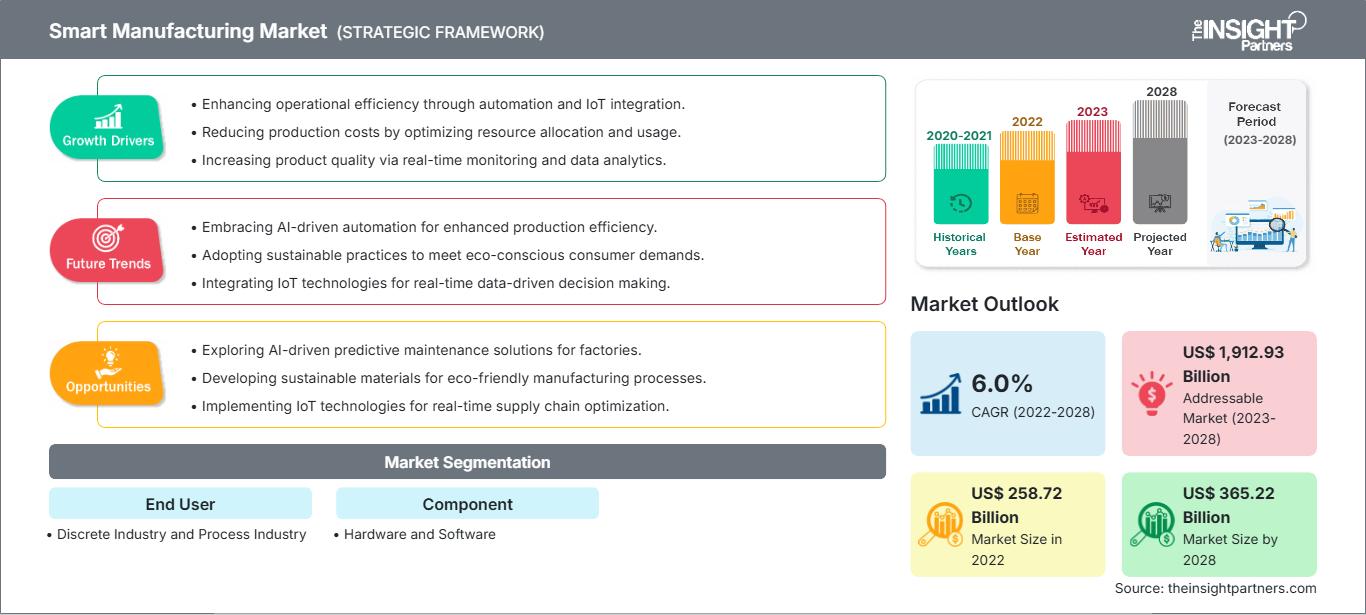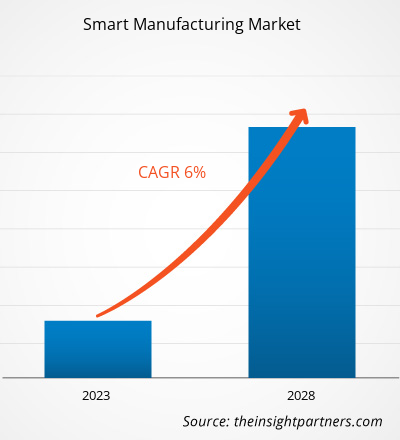[연구 보고서] 스마트 제조 시장은 2022년 2,496억 2,800만 달러에서 2028년 3,652억 2,000만 달러로 성장할 것으로 예상되며, 2022년부터 2028년까지 연평균 성장률 6.0%로 성장할 것으로 예상됩니다.
분석가 관점:
스마트 제조 시장은 최근 몇 년간 상당한 성장과 혁신을 경험했습니다. 스마트 제조 또는 인더스트리 4.0 또는 제4차 산업 혁명은 인공지능(AI), 사물인터넷(IoT), 클라우드 컴퓨팅, 빅데이터 분석, 로봇 공학과 같은 첨단 기술을 제조에 통합하는 것을 의미합니다. 스마트 제조 솔루션은 효율성, 생산성, 유연성을 향상시켜 기존 제조 운영을 혁신했습니다. 이러한 기술은 실시간 모니터링, 자동화, 예측 유지 보수, 지능적 의사 결정을 가능하게 하여 품질 관리 개선, 가동 중단 시간 감소, 공급망 최적화 및 비용 절감을 실현합니다. 스마트 제조 시장은 자동차, 항공우주, 전자, 제약, 식음료, 소비재 등 다양한 산업을 아우릅니다. 특히 자동차 산업은 생산 효율을 높이고, 제품 맞춤화를 강화하며, 전기 자동차와 자율주행에 대한 증가하는 수요를 충족하기 위해 스마트 제조 방식을 도입해 왔습니다. 스마트 제조는 운영 효율성 향상 외에도 지속가능성과 환경 영향에도 중점을 둡니다. 자원 활용 최적화, 폐기물 감소, 에너지 효율적인 관행 구현을 통해 제조업체는 탄소 발자국을 최소화하고 지속가능한 발전에 기여할 수 있습니다. 글로벌 스마트 제조 시장은 향후 몇 년 동안 성장할 것으로 예상됩니다. 이러한 성장을 주도하는 요인으로는 자동화 수요 증가, 실시간 데이터 분석 및 예측 유지보수의 필요성, IoT 기기 및 클라우드 플랫폼 도입 증가 등이 있습니다. 또한, 5G 연결 및 엣지 컴퓨팅과 같은 기술 발전은 스마트 제조 솔루션 도입을 가속화할 것으로 예상됩니다.
시장 개요:
"스마트 제조"라는 용어는 전 세계적으로 점점 더 많이 도입되고 있는 혁신적이고 통합된 생산 기술 및 솔루션 개발을 기반으로 하는 글로벌 산업 전략을 설명합니다. 생산 운영을 최적화하고 확장 가능하게 제어하려면 인터넷을 통해 기계가 상호 연결되는 제조 공장 시스템을 도입해야 합니다. 스마트 제조 분야에서 잘 알려진 기술로는 산업용 사물 인터넷(IIoT), 제조 블록체인, 로봇 공학, ERP 시스템, 예방 정비, 증강 현실 및 가상 현실, 데이터 분석, 자동 포장 등이 있습니다. 이러한 이유로 산업계는 생산 효율을 높이기 위해 이러한 기술을 적용하는 새로운 방법에 대한 투자와 개발을 지속하고 있습니다. 또한 시장 제품 경쟁력 강화를 위한 노력도 확대되고 있습니다. 미국 산업계, 기술 공급업체, R&D 시설, 그리고 대학들이 참여하는 스마트 제조 리더십 연합(Smart Manufacturing Leadership Coalition)은 차세대 스마트 제조 플랫폼과 스마트 팩토리 연결성을 구축하고 있습니다.
이 보고서의 일부, 국가 수준 분석, Excel 데이터 팩을 포함하여 모든 보고서에 대한 사용자 정의를 무료로 받을 수 있을 뿐만 아니라 스타트업 및 대학을 위한 훌륭한 제안 및 할인을 이용할 수 있습니다
스마트 제조 시장: 전략적 통찰력

- 이 보고서의 주요 주요 시장 동향을 확인하세요.이 무료 샘플에는 시장 동향부터 추정 및 예측에 이르기까지 데이터 분석이 포함됩니다.
시장 성장 동력:
산업용 로봇 도입 증가로 스마트 제조 시장 성장 견인
산업 자동화 필요성이 커짐에 따라 산업용 로봇 도입이 증가하고 있습니다. 산업용 로봇은 전자 산업의 성장과 제조 인건비 증가로 시장 성장에 기여해 왔습니다. 이는 연구 기간 동안 산업용 로봇 수요 증가로 이어져 스마트 제조 시장 성장을 뒷받침할 것으로 예상됩니다. 친환경 기술과 에너지 효율에 대한 관심이 높아짐에 따라, 기업들은 전력 소모가 적고 에너지 효율이 높은 스마트 제조를 통해 시장 점유율을 높이고 신규 고객을 유치할 수 있습니다. 예측 기간 동안 친환경 시스템에 대한 투자는 엄청난 규모로 증가할 것으로 예상됩니다. 산업용 로봇은 제조 산업에서 제품 효율성, 생산성 및 품질을 향상시키기 위해 점점 더 많이 사용되고 있습니다. 산업용 로봇은 높은 정밀도, 속도 및 정확도로 반복 작업을 수행할 수 있어 오류를 줄이고 제품 품질을 향상시키는 데 도움이 됩니다. 사람이 수행하기 위험하거나 어려운 작업, 예를 들어 안전하지 않은 환경에서 작업하거나 상당한 크기의 물체를 옮기는 작업도 로봇이 수행합니다. 산업용 로봇 도입 증가에 따라 머신 러닝, 인공지능, 사물 인터넷(IoT)과 같은 신기술이 개발되어 로봇이 더욱 스마트하고 효율적으로 작동할 수 있도록 지원합니다. 이러한 기술은 인간 및 다른 로봇과 협력하여 복잡한 제조 작업을 수행할 수 있는 차세대 스마트 로봇을 개발하는 데 도움이 됩니다. 산업용 로봇 도입 증가는 제조 공정 최적화 및 제품 품질 향상에 사용되는 자동화 솔루션, 데이터 분석 및 기타 기술에 대한 수요를 증가시켜 스마트 제조 시장 확대를 촉진하고 있습니다.
세분화 분석:
최종 사용자 기준으로 스마트 제조 시장은 개별 산업과 공정 산업으로 구분됩니다. 개별 산업은 2020년에 시장 점유율이 가장 높았으며, 예측 기간 동안 시장에서 가장 높은 CAGR을 기록할 것으로 예상됩니다. 스마트 제조 시장에서 개별 제조 부문은 자동차, 항공우주, 방위 산업 등 개별 제조 공정의 자동화 및 디지털화 수요 증가로 가장 큰 점유율을 기록했습니다. 이러한 산업에서 스마트 제조 기술을 도입함으로써 효율성 향상, 비용 절감, 품질 관리 강화가 가능해졌습니다. 이는 스마트 제조 솔루션에 대한 수요 증가로 이어져 개별 제조 부문의 성장을 견인했습니다. 또한, 인더스트리 4.0과 산업용 사물 인터넷(IIoT)에 대한 관심이 높아지면서 스마트 제조 시장의 개별 제조 부문 성장이 더욱 가속화될 것으로 예상됩니다.
지역 분석:
아시아 태평양 스마트 제조 시장은 2022년 787억 6천만 달러 규모였으며, 2028년에는 1억 1,153만 달러에 이를 것으로 예상됩니다. 예측 기간 동안 연평균 성장률(CAGR)은 5.5%에 이를 것으로 예상됩니다. 아시아 태평양 지역은 가장 큰 시장 점유율을 차지했으며, 예측 기간 동안 가장 빠른 성장을 경험할 것으로 예상됩니다. 중국과 인도와 같은 개발도상국들은 스마트 제조의 완전 자동화를 추진하고 있습니다. 이 시장에는 아직 개발되지 않은 잠재력이 매우 많기 때문입니다. 여러 요인으로 인해 아시아 태평양 지역은 스마트 제조 시장에서 주도적인 역할을 하고 있습니다. 이 지역이 주도적인 위치를 점하는 주된 이유 중 하나는 정부와 민간 기관이 첨단 제조 기술 개발에 막대한 투자를 하고 있기 때문입니다. 중국, 일본, 한국과 같은 국가들은 제조 공정 개선 및 생산성 향상을 위해 로봇 공학, 인공지능, 사물 인터넷(IoT)과 같은 기술 개발에 막대한 투자를 하고 있습니다. 정부 및 민간 부문의 투자 외에도 아시아 태평양 지역은 첨단 제조 기술 개발 및 구축에 필수적인 광범위하고 숙련된 인력을 보유하고 있습니다. 이 지역에는 제조 부문에서 신기술을 개발하고 구현할 수 있는 고도로 숙련된 엔지니어, 과학자, 기술자 풀이 풍부합니다. 아시아 태평양 지역은 또한 전자 및 자동차 분야를 중심으로 세계 유수의 제조 기업들이 진출해 있는 지역입니다. 이러한 기업들은 효율성 향상, 비용 절감, 생산성 향상을 위해 첨단 제조 기술 개발에 막대한 투자를 하고 있습니다. 그 결과, 아시아 태평양 지역은 제조 부문 혁신의 중심지로 자리 잡고 있으며, 전 세계적으로 출시되기 전에 수많은 신기술이 개발 및 테스트되고 있습니다. 맞춤형 제품에 대한 수요 증가는 아시아 태평양 지역의 스마트 제조 시장 발전을 촉진하고 있습니다. 소비자들의 요구가 점점 더 높아지고 자신의 니즈를 충족하는 제품을 기대함에 따라, 제조업체들은 3D 프린팅 및 머신 러닝과 같은 첨단 기술을 활용하여 맞춤형 제품을 빠르고 효율적으로 제작하고 있습니다. 아시아 태평양 지역은 세계 유수의 3D 프린팅 기업들이 이 지역에 기반을 두고 있어 이러한 추세를 활용할 수 있는 유리한 위치에 있습니다. 마지막으로, 아시아 태평양 지역은 제조 분야에서 클라우드 컴퓨팅과 빅데이터 분석의 중요성이 높아지는 것도 큰 도움이 되고 있습니다. 이러한 기술은 센서, 기계 및 기타 장치를 포함한 다양한 소스에서 방대한 양의 데이터를 수집하고 분석하여 제조 공정 및 제품 품질 개선에 활용할 수 있는 패턴과 트렌드를 파악하는 데 활용되고 있습니다. 이 지역은 대규모의 성장하는 클라우드 컴퓨팅 인프라를 보유하고 있으며, 이는 제조 부문에서 이러한 기술 도입을 촉진하는 데 기여하고 있습니다.
주요 기업 분석:
스마트 제조 시장 분석은 요코가와 전기(Yokogawa Electric Corporation), 시스코 시스템즈(Cisco Systems, Inc), 허니웰 인터내셔널(Honeywell International Inc.), 3D 시스템즈(3D Systems, Inc), 다이후쿠(Daifuku Co., Ltd), 제너럴 일렉트릭(General Electric), IBM, 오라클(Oracle), 지멘스(Siemens AG), 슈나이더 일렉트릭(Schneider Electric SE) 등의 기업으로 구성됩니다. 스마트 제조 분야 기업 중 시스코 시스템즈(Cisco Systems, Inc.)와 지멘스(Siemens AG)는 다양한 제품 포트폴리오를 바탕으로 상위 2개 기업으로 분류됩니다.
스마트 제조 시장 지역별 통찰력
The Insight Partners의 분석가들은 예측 기간 동안 스마트 제조 시장에 영향을 미치는 지역별 동향과 요인들을 면밀히 분석했습니다. 이 섹션에서는 북미, 유럽, 아시아 태평양, 중동 및 아프리카, 그리고 중남미 지역의 스마트 제조 시장 세분화 및 지역별 분포도 살펴봅니다.
스마트 제조 시장 보고서 범위
| 보고서 속성 | 세부 |
|---|---|
| 시장 규모 2022 | US$ 258.72 Billion |
| 시장규모별 2028 | US$ 365.22 Billion |
| 글로벌 CAGR (2022 - 2028) | 6.0% |
| 이전 데이터 | 2020-2021 |
| 예측 기간 | 2023-2028 |
| 다루는 세그먼트 |
By 최종 사용자
|
| 포함된 지역 및 국가 | 북미
|
| 시장 선도 기업 및 주요 회사 프로필 |
|
스마트 제조 시장 참여자 밀도: 비즈니스 역학에 미치는 영향 이해
스마트 제조 시장은 소비자 선호도 변화, 기술 발전, 그리고 제품 이점에 대한 인식 제고 등의 요인으로 인한 최종 사용자 수요 증가에 힘입어 빠르게 성장하고 있습니다. 수요가 증가함에 따라 기업들은 제품 및 서비스를 확장하고, 소비자 니즈를 충족하기 위한 혁신을 추진하며, 새로운 트렌드를 적극 활용하고 있으며, 이는 시장 성장을 더욱 가속화하고 있습니다.

- 을 얻으세요 스마트 제조 시장 주요 주요 플레이어 개요
최근 동향:
스마트 제조 시장에서는 인수합병과 같은 비무기적 및 유기적 전략이 활발하게 활용되고 있습니다. 최근 주요 시장 동향은 다음과 같습니다.
- 2022년 10월 - ABB는 미션 크리티컬 애플리케이션용 고출력 터보차저 분야의 선구자인 Accelleron Industries AG가 스위스 취리히 SIX 거래소에서 "ACLN"이라는 티커 기호로 거래 개시 승인을 받았다고 발표했습니다. 이는 Accelleron이 ABB에서 분사되는 과정을 완료하기 위한 것입니다.
- 2022년 7월 - ABB와 SKF는 제조 공정 자동화 분야의 협력 가능성을 모색하기 위한 양해각서(MoU)를 체결했습니다. 이 파트너십을 통해 양사는 제조 역량을 개선하고 고객의 생산 효율 향상을 지원하는 솔루션을 모색하고 평가할 것입니다.
- 과거 분석(2년), 기준 연도, CAGR을 포함한 예측(7년)
- PEST 및 SWOT 분석
- 시장 규모 가치/거래량 - 글로벌, 지역, 국가
- 산업 및 경쟁 환경
- Excel 데이터세트
최근 보고서
사용 후기
구매 이유
- 정보에 기반한 의사 결정
- 시장 역학 이해
- 경쟁 분석
- 고객 인사이트
- 시장 예측
- 위험 완화
- 전략 기획
- 투자 타당성 분석
- 신흥 시장 파악
- 마케팅 전략 강화
- 운영 효율성 향상
- 규제 동향에 발맞춰 대응




















 무료 샘플 받기 - 스마트 제조 시장
무료 샘플 받기 - 스마트 제조 시장